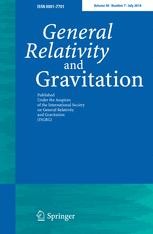GRG Editor's Choice: Gravitational lensing beyond geometric optics – II. Metric independence
 Harte, A.I., Gravitational lensing beyond geometric optics: II. Metric independence, Gen Relativ Gravit (2019) 51: 160. https://doi.org/10.1007/s10714-019-2646-7
Harte, A.I., Gravitational lensing beyond geometric optics: II. Metric independence, Gen Relativ Gravit (2019) 51: 160. https://doi.org/10.1007/s10714-019-2646-7
Editor's Choice (Research Article)
First Online: 07 December 2019
"I was also the referee of the first part of this project, and the compliments which I formulated back then equally apply to this second part. This is again an excellent, interesting, extremely clear, well-written, and in-depth work for which I would like to congratulate the author."
Abstract:
Typical applications of gravitational lensing use the properties of electromagnetic or gravitational waves to infer the geometry through which those waves propagate. Nevertheless, the optical fields themselves—as opposed to their interactions with material bodies—encode very little of that geometry: it is shown here that any given configuration is compatible with a very large variety of spacetime metrics. For scalar fields in geometric optics, or observables which are not sensitive to the detailed polarization content of electromagnetic or gravitational waves, seven of the ten metric components are essentially irrelevant. With polarization, five components are irrelevant. In the former case, this result together with diffeomorphism invariance allows essentially any geometric-optics configuration associated with a particular spacetime to be embedded into any other spacetime, at least in finite regions. Going beyond the geometric-optics approximation breaks some of this degeneracy, although much remains even then. Overall, high-frequency wave propagation is shown to be insensitive to compositions of certain conformal, Kerr–Schild, and related transformations of the background metric. One application is that new solutions for scalar, electromagnetic, and gravitational waves may be generated from old ones. In one example described here, the high-frequency scattering of a plane wave by a point mass is computed by transforming a plane wave in flat spacetime.
The author:
Abraham Harte is Assistant Professor in the School of Mathematical Sciences at Dublin City University, Ireland. He research interests are general relativity and gravitational physics: theory of motion (self-force and extended-body effects), wave propagation in curved spacetimes, gravitational lensing, and gravitational waves.
GRG Editor's Choice:
In each volume of GRG, a few papers are marked as “Editor’s Choice”. The primary criteria is original, high quality research that is of wide interest within the community.
